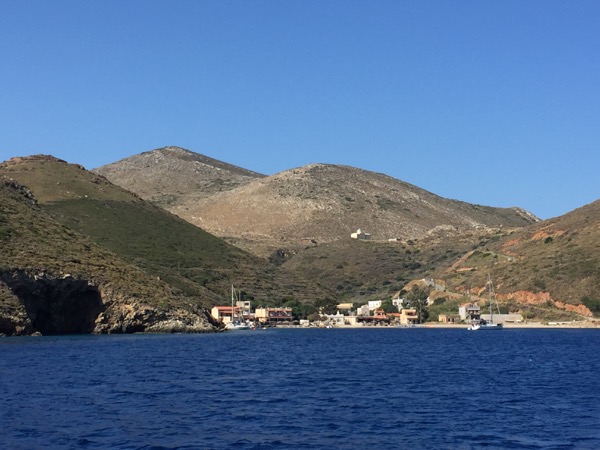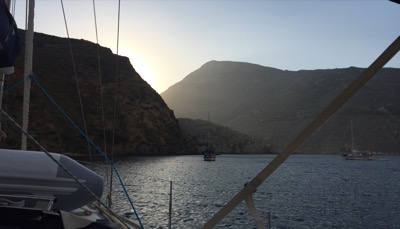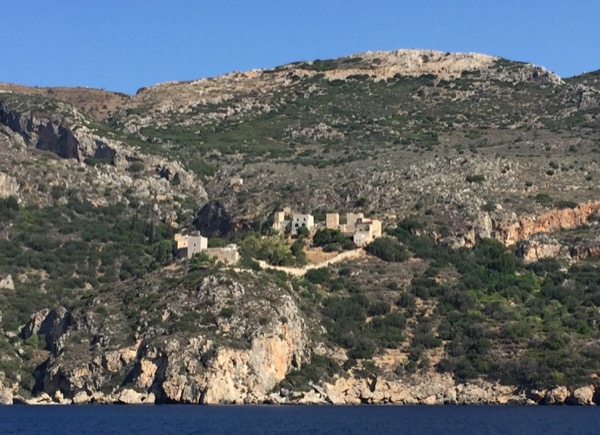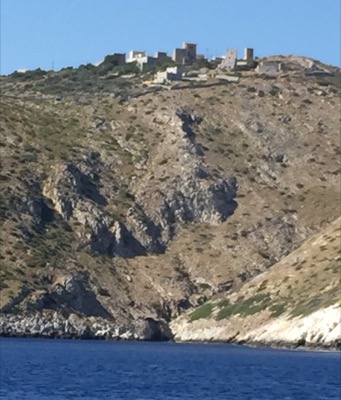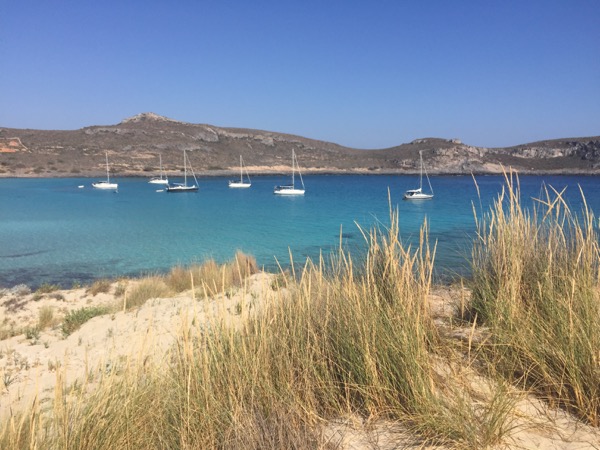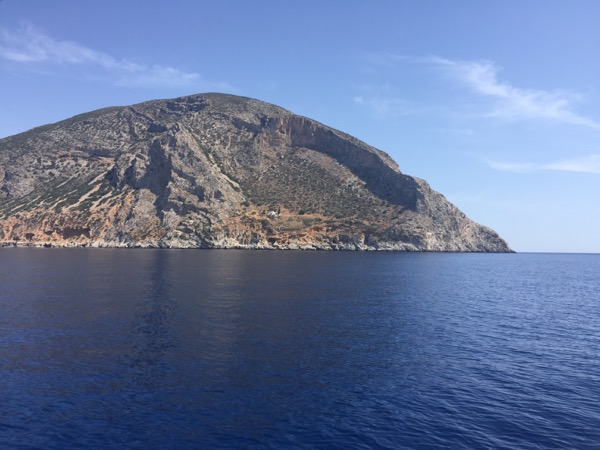Turtles, Spartans, dolphins and the Tip of Doom
2nd - 5th June
Cape Malea, the eastern and southernmpst tip of the Peloppenes, known onboard Wonderer as 'the Tip of Doom', is notoriously treacherous and difficult to navigate, featuring variable weather and occasionally very powerful storms. This is where Odysseus was blown off course for 10 years on his route back to Ithaca from Troy. To round or not to round? After much vacillation and numerous consultations we went for it.
Heading south east from Kalamata along the mountainous range of the Mani peninsula the mountainous landscape became drier with steep cliffs falling into the sea. The coastline is dramatic and inhospitable, with few bolt holes and bays in which to seek shelter. We had a calm day's motoring however down to the old village and bay of Limeni which offers some shelter. We found room on the small quay next to another couple of yachts, with an unsettled night of rough seas however. The scenery in the bay was so worth it though. The 'neo-Maniote' architecture was very different from the Venetian feel of the first finger of the Peloppenese. Grey stone houses with tiny windows and towers, each dwelling like a small castle. Cycling round the bay to the village of Limeni was very picturesque.
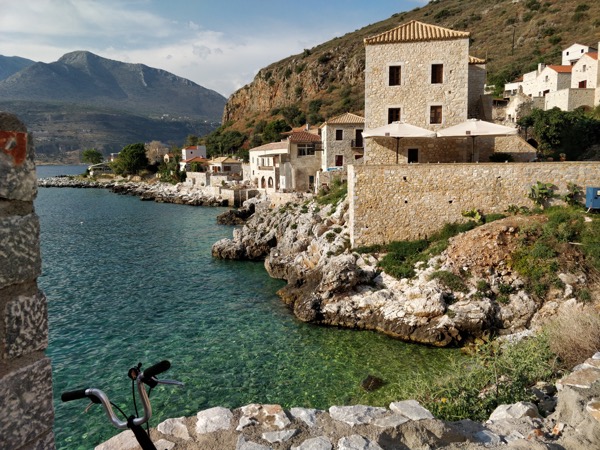
Swimming off the quay we saw a giant turtle swimming in the waves nearby with remarkable agility, so different from seeing turtles on land. Astonishing to discover that these 'loggerhead' or Caretta Caretta turtles, the world's largest hard-shelled turtle, are relatives of the early dinosaurs and have been on the planet for 250 million years. They are currently listed as Threatened, meaning likely to become in danger of extinction in the foreseeable future. Adult length is typically 80-110cm and they live for 45-67 years. They migrate great distances, but return to the beach of their own hatching - for mating and breeding. How do they navigate so well? Apparently an iron compound in their brain called magnetite allows them to perceive the earth's magnetic field for navigation. They also navigate by sight. Fascinating to be introduced to this extraordinary species.
I digress. But that is the beauty of this journey, to be digressed by such wonderful things.
By the time we got to the tip of the Mani peninsula and rounded the lighthouse we were under sail in a gentle breeze.
As soon as we jibed round the tip the wind started gusting off the headland at 26 knots. With two reefs in the main and the genoa furled to the size of a handkerchief we were still sailing fast. Our destination Porto Kayio was not far away, we were glad to head into calmer waters in this bay.
Our first anchor drop was on rocky ground and did not hold so after our second I dived down to have a look at the holding. Once only. Our washing line now doubles as a depth gauge with a weight on the end. Your ears hurt when you dive that deep! It was only 5 meters. It's a mystery to me how people free dive at such great depths. Current record 214 meters. Apparently they remain intact and alive afterwards.
In Porto Kayio the barrenness of this region really came home to us. The stark, tower-like houses in grey stone with small windows were the same style as in Limeni and very different from the Venetian feel of the first finger in the Peloppenese.
The barren bleakness of this mountainous region must have contributed to the piracy and violent vendettas that characterised these parts in centuries past.
Wikipedia: 'Usually, the decision to start a vendetta was made at a family gathering. The main aim of a vendetta was usually to wipe out the other family. The families involved locked themselves in their towers and whenever they got the chance murdered members of the opposing family. The other families in the village normally locked themselves in their towers in order not to get in the way of the fighting. Some vendettas went on for months, sometimes years. In vendettas, the families could have a truce or treva, if one family needed to attend a religious ceremony or when it was time to harvest the crops. As soon as the treva ended, the killing could resume. Vendettas usually ended when one family was exterminated or when the defeated family left the town.'
Explains the architecture! And of course the ancestors of the Maniots were the Spartans, the highly trained warriors of ancient Greece. We are in the Laconic Gulf. When Philip 2nd invaded southern Greece and other city-states had surrendered, he sent this message to Sparta: 'You are advised to submit without further delay, for if I bring my army into your land, I will destroy your farms, slay your people, and raze your city. The Spartans replied: "If". Their Laconic peninsula is an impressively forbidding place.
Secure at anchor but a fairly lumpy night later we set off east across the Laconic Gulf heading for The Island of Anxiety, or Elaphonissos as it is also known, the last stop before rounding Cape Malea. A calm crossing with a mix of engine and sail, we were blessed by a visit of a pod of 7-8 meter-long dolphins come for a spot of bowriding. They swam with us for what seemed like ages and must have been 10 minutes, keeping pace with us like arrows inches from right and left of the bow and, weaving in and out in front or peeling off to the side, only to join again later.
Click HERE to see the dolphins swimming
It was such a joy. We could clearly see their breathing hole open and close as they came to the surface for air, and as they turned to the side we saw their eyes. We also spotted the strangest thing: a large blue-grey fish attached to the dolphin! One dolphin had two such fish attached, I could see the eye of the fish as it raced through the water attached to the dolphin. So bizarre. They must have been 'Remora fish', looking up at us with their hair slicked back lying flat against the side of the dolphin as it raced along beside our bow. Remoras have evolved large suction cups to attach to an individual dolphin or shark for up to 3 months at a time.
The 'Island of Anxiety' presented as fairly harmless and very beautiful indeed.
Once again a very rolling night however, before setting off in the much calmer waters and no wind of the morning to round the dread Cape Malea by motor in flat calm (as below).
We did it!
Spot the tiny white buildings?
A monastery.

